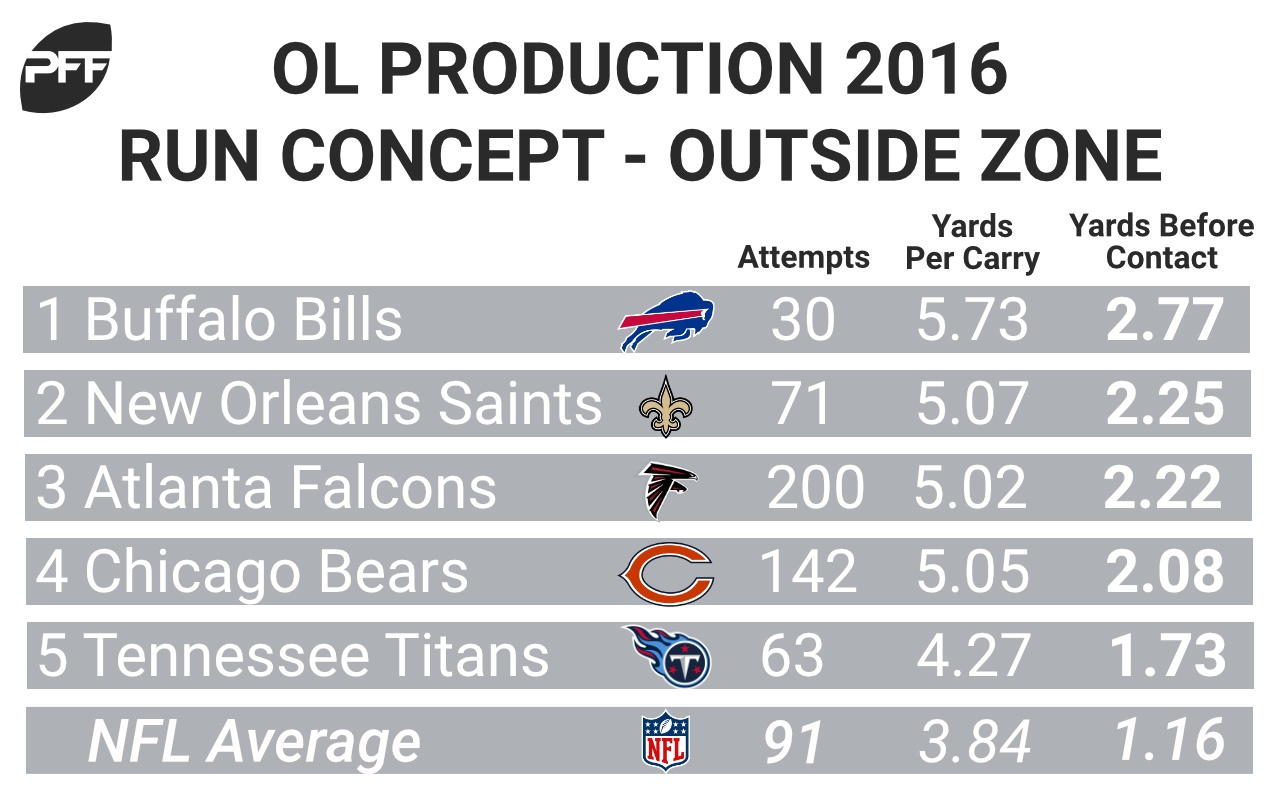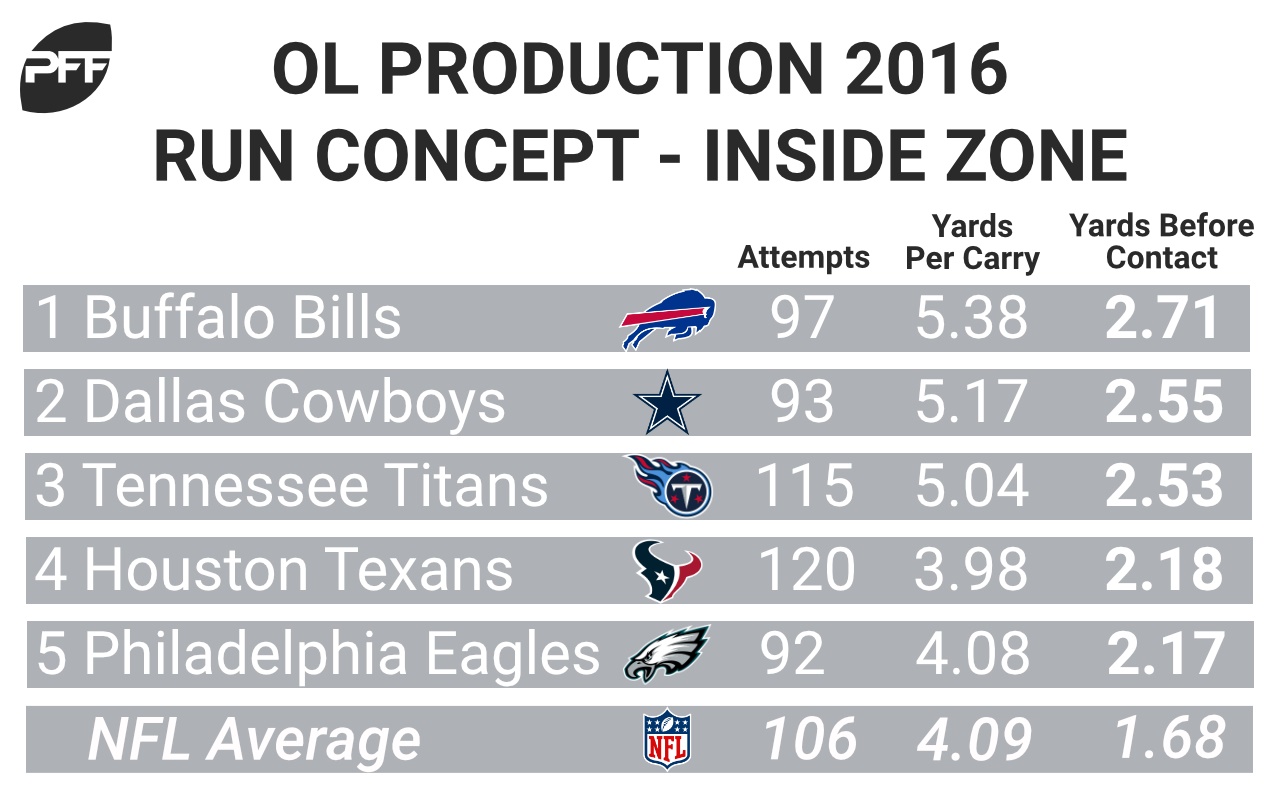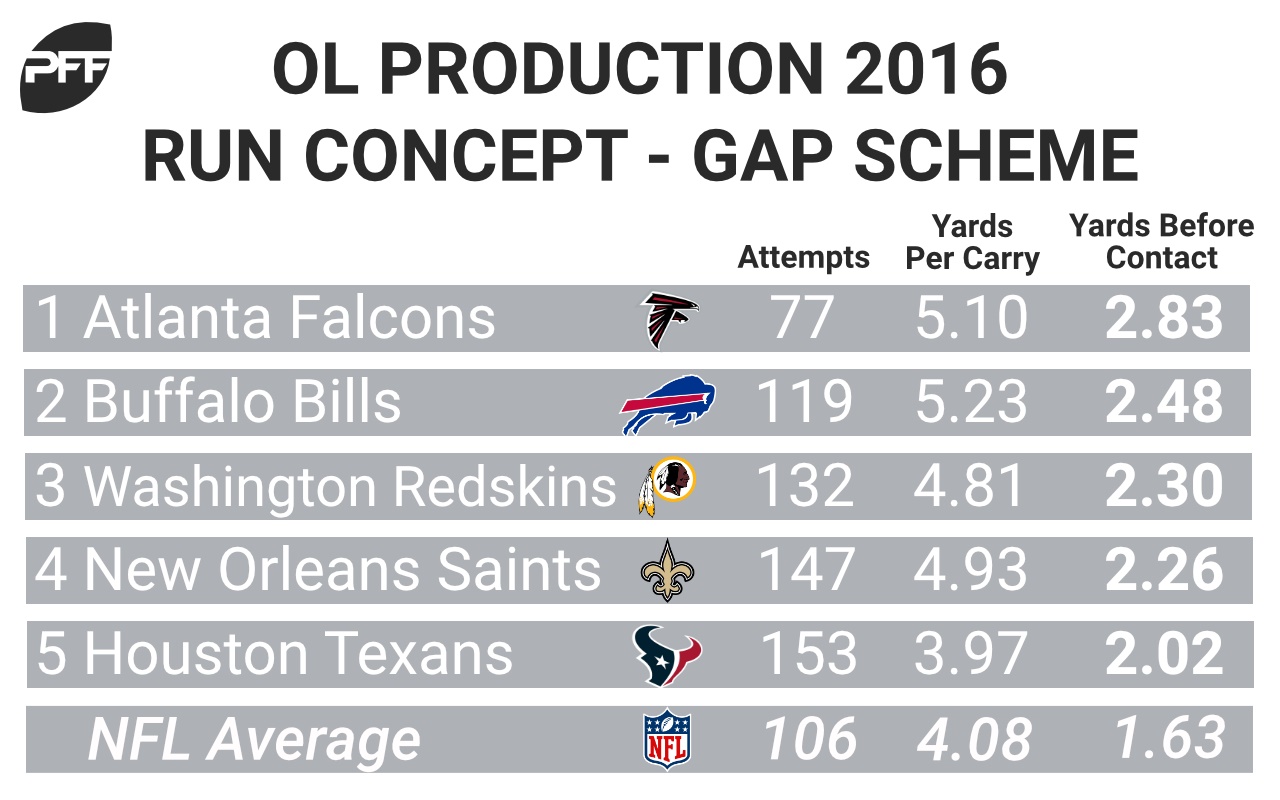The goal in football is to gain yards, and while many run plays may look different, they can be broadly categorized into different schemes or run concepts based on what the blocking is designed to do in front of the ball carrier.
While one run concept may work for one team it does not necessarily mean that it will be successful for the other teams too, and some teams lean far more heavily on a specific run concept than others. We have categorized last season’s running plays into three groups – outside zone, inside zone, and gap scheme – and examined how each team performed on these run concepts.
Here’s a look at the most interesting takeaways from this research.
Join PFF Elite for access to PFF Signature Stats across all positions.
Outside Zone
Out of the three categories of run concepts, outside zone was without a doubt the one that gave offensive lines the most problems. As a matter of fact, teams averaged just 3.84 yards on these plays leaguewide, which is the lowest out of the three examined categories. Furthermore, running backs averaged just 1.16 yards before contact on these runs, which is significantly lower than that of inside zone runs and gap scheme runs.
The success of an outside zone play can largely depend on how the center executes a reach block. As a result, it comes as no surprise that Atlanta and Denver, which ran the most and third-most outside zone plays, respectively, had two of the best centers in the NFL last season. Denver’s Matt Paradis had the highest run-blocking grade (90.6) last season, while Atlanta’s Alex Mack ranked third at 89.3.
Ball carriers of five teams (Carolina, Oakland, San Diego, San Francisco, and the New York Giants) averaged negative yards before contact on outside zone runs. The lowest figure belonged to the Giants, whose running backs averaged -1.0 yards before contact on these type of plays. None of these five teams are what you would consider “zone blocking” teams, and none used outside zone plays more than 50 times.
There were four teams that were extremely successful on outside zone plays — Chicago, Atlanta, New Orleans and Buffalo all averaged more than 5.0 yards on outside zone runs and were in fact the only teams that allowed their running backs to gain more than 2.0 yards per carry on these plays, albeit on a low sample size of just 30 carries in Buffalo's case.
While outside zone runs paid dividends to most teams that used it frequently, there were four teams that ran more than 100 outside zone plays and their running backs still averaged less than 1.0 yard before contact on these runs. In fact, Cincinnati’s, Green Bay’s, Washington’s and New England’s ball carriers ranked 18th, 19th, 20th, and 23rd in this category, respectively.
Inside Zone
Although there was only a slight difference, inside zone was the most successful run concept in 2016 out of the three categories examined. Teams averaged 4.09 yards per run on these plays while running backs averaged 1.68 yards before contact, both ranked first among the three categories.
While precisely half of the league – 16 teams – averaged less than 1.0 yard before contact on outside zone plays, there were only three teams whose running backs did not gain an average of one yard before being contacted by a defender when running inside zone. Minnesota’s running backs faced the biggest challenge as they averaged just 0.76 yards before contact on inside zone, while Carolina and Kansas City ranked 31st and 30th with 0.90 and 0.96 yards, respectively.
Oakland ranked third in the league with 5.08 yards per attempt on inside zone plays, but this was also due to their running backs gaining significant yards after contact – a trend that should continue with the addition of Marshawn Lynch – as they ranked only eighth with 1.99 yards before contact on inside zone runs.
There were three teams that were able to create an average of 2.5 yards or more before contact for their running backs on inside zone runs and two of them – Tennessee and Dallas – were the top two offensive line units in last season. However, Buffalo’s running backs – anchored by LeSean McCoy – led the NFL in yards before contact on inside zones at 2.71 yards. They were followed by the Cowboys and the Titans whose running backs averaged 2.55 and 2.53 yards, respectively.
San Francisco ran the most inside zone plays last season with 246 while only one other team ran more than 140 inside zone runs; the Seattle Seahawks. The 49ers were in the top half of the league in yards per attempt on these plays, ranking 11th with 4.17 yards, this was largely due to their running backs gaining yards after contact, proven by the fact that their 1.32 yards before contact on these plays ranked only 23rd in the league.
Gap Scheme
Since this category includes multiple run concepts, unlike outside zone and inside zone; it comes as no surprise that this was the most featured run concept in the NFL last season with 3,969 attempts, including playoffs. While it was only San Francisco that ran either inside or outside zone more than 200 times; New England, Pittsburgh and Arizona all ran more than 200 gap scheme plays over the season with the Patriots leading all teams with 247 such plays, including the playoffs.
The five most successful teams on this play were Atlanta, Buffalo, Washington, New Orleans, and Houston as all of these teams’ running backs averaged more than 2.0 yards before contact on gap scheme runs. In fact, Atlanta was not far from an average of 3.0 yards before contact as they led all teams at 2.83 on their 77 gap scheme runs thanks to speedy backs that could take advantage of big holes opened up by the blocking.
Cleveland’s running backs excelled at creating yards after contact on gap scheme runs as the Browns ranked third in the league with 5.09 yards per attempt on these plays, but just 18th with 1.50 yards before contact. As a result, their running backs led the league with 3.58 yards after contact on gap scheme runs.
Even though Tampa Bay ran the 13th-most gap scheme runs with 133 such plays, they struggled the most on these runs. There were only two teams that averaged less than a yard before contact on gap scheme runs and while Baltimore ranked 31st with 0.97 yards, the Buccaneers were dead last with 0.78 yards before contact on these plays.
Although the Texans ranked fifth in the league with 2.02 yards before contact on gap scheme runs, their running backs were mostly unable to take advantage of what the offensive line created for them. In fact, Houston ball carriers averaged just 1.95 yards after contact on gap scheme runs, which ranked 29th in the league. Consequently, the Texans ranked just 16th in the league with 3.97 yards per attempt on these plays.






 © 2025 PFF - all rights reserved.
© 2025 PFF - all rights reserved.